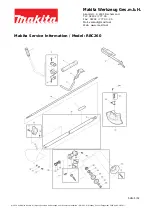
1.7 Never lay metal tools, such as wrenches or
screwdrivers, on top of a battery.
1.8 Disconnect the battery from the truck when
performing maintenance and repair on motor or
electrical system.
1.9 Open or “break” the battery circuit before
attempting repairs to the charging plug or
receptacles.
1.10 Apply a strong neutralizer, such as baking soda
or soda ash, when electrolyte is spilled on the
floor. Check local regulations regarding the
disposal of neutralized waste.
2. RECEIVING BATTERIES
Immediately upon receipt of shipment, examine the
outside of the packing for signs of rough handling
before accepting the battery from the carrier. Wet
spots on the shipping pallet may be an indication of
leaking jars broken in shipment.
If there is evidence of damage, the receipt should be
signed and both copies (carrier’s and receiving copies)
marked “Shipment Received Damaged”. The carrier
should be called immediately and asked to make a
“Carrier’s Inspection for Damage Report”.
If “concealed” damage is later detected, the carrier
should be called immediately and requested to make
a “Carrier’s Inspection for Concealed Damage
Report”. After inspection by the carrier, arrangements
should be made with the local GNB
®
Industrial Power
representative to have the battery repaired before
placing it in service.
FLOODED FLAT-PLATE FAST CHARGE
MOTIVE POWER BATTERIES
INSTALLATION AND OPERATING INSTRUCTIONS
PLEASE READ BEFORE PLACING BATTERIES IN SERVICE
THESE INSTRUCTIONS TO BE SHIPPED WITH
BATTERY AND TO BE DELIVERED TO USER
1. SAFETY
1.1 Follow your company’s Safety Instructions when
working with or near industrial truck batteries.
Observe the caution label affixed to the battery.
Thoroughly familiarize yourself with industry and
government
guidelines
(OSHA,
ANSI)
for
charging, handling, and maintaining industrial
batteries.
1.2 Assign battery and charger care to properly
trained personnel.
1.3 This battery contains sulfuric acid electrolyte.
Avoid contact with skin, eyes, or clothing. Wear
rubber apron, gloves, boots, and goggles or face
shield when handling, checking, filling, charging
or repairing batteries.
1.4 Keep water readily available for flushing spilled
electrolyte from eyes or skin. Use plain water
only and obtain medical attention immediately.
Special deluge showers and eye wash basins
are required.
1.5 Batteries produce hydrogen and oxygen gas
during charge. Keep open flames away. Do not
check electrolyte level with a cigarette lighter or
match. Use a flashlight or permanent lights.
Switch on/off away from the top of the battery. Do
not smoke or create sparks.
1.6 Lift batteries with a certified/approved hoist,
crane, lift truck, or similar equipment. Move
batteries with trucks, conveyors, or rollers. Be
sure to place a rubber mat or similar insulating
material across the tops of coverless batteries
when handling. Make sure equipment is of ample
strength and properly installed.
P O S T
T H E S E
I N S T R U C T I O N S
I N
T H E BAT T E RY M A I N T E N A N C E A R E A .
L
E
A
D
R
E
T
U
R
N
RECYCLE
A Division of Exide Technologies
GNB Industrial Power
USA – Tel: 888.563.6300
Canada – Tel: 800.268.2698
Spanish and French versions of
this document can be found at
www.gnb.com
GB4145 2011-10
DO NOT USE CHAIN OR WIRE ROPE SLINGS.
Содержание GB4145
Страница 2: ......






















